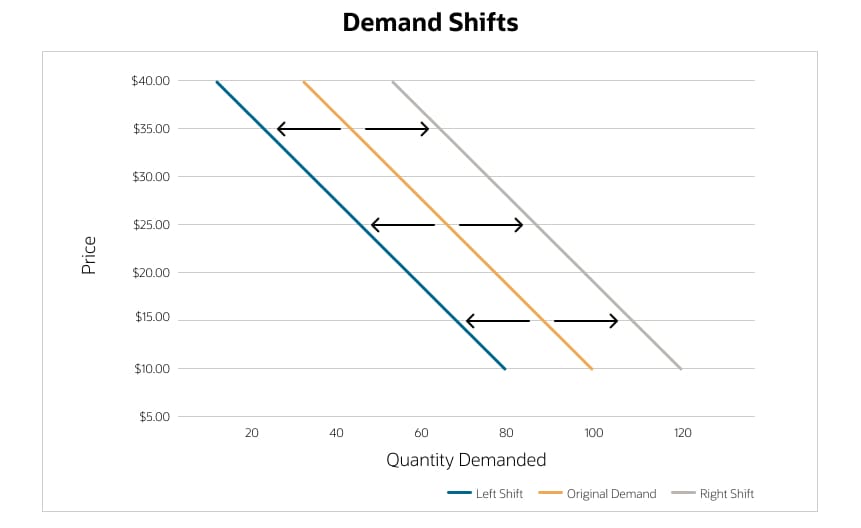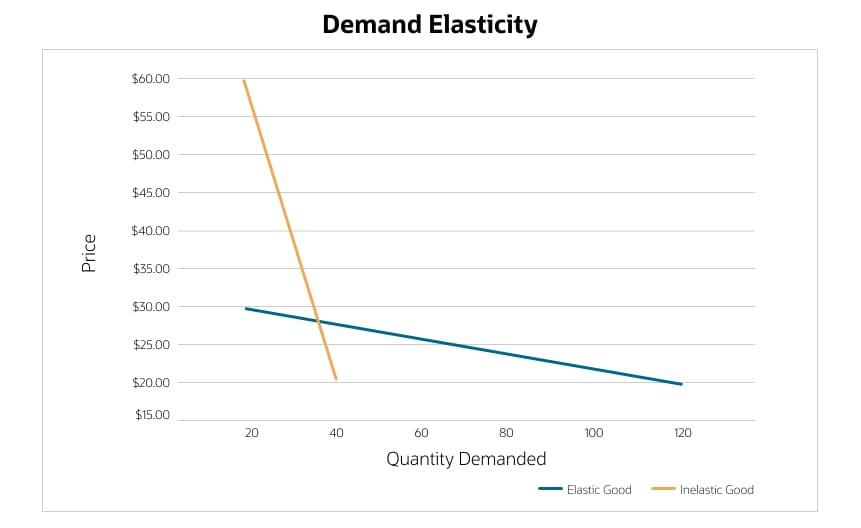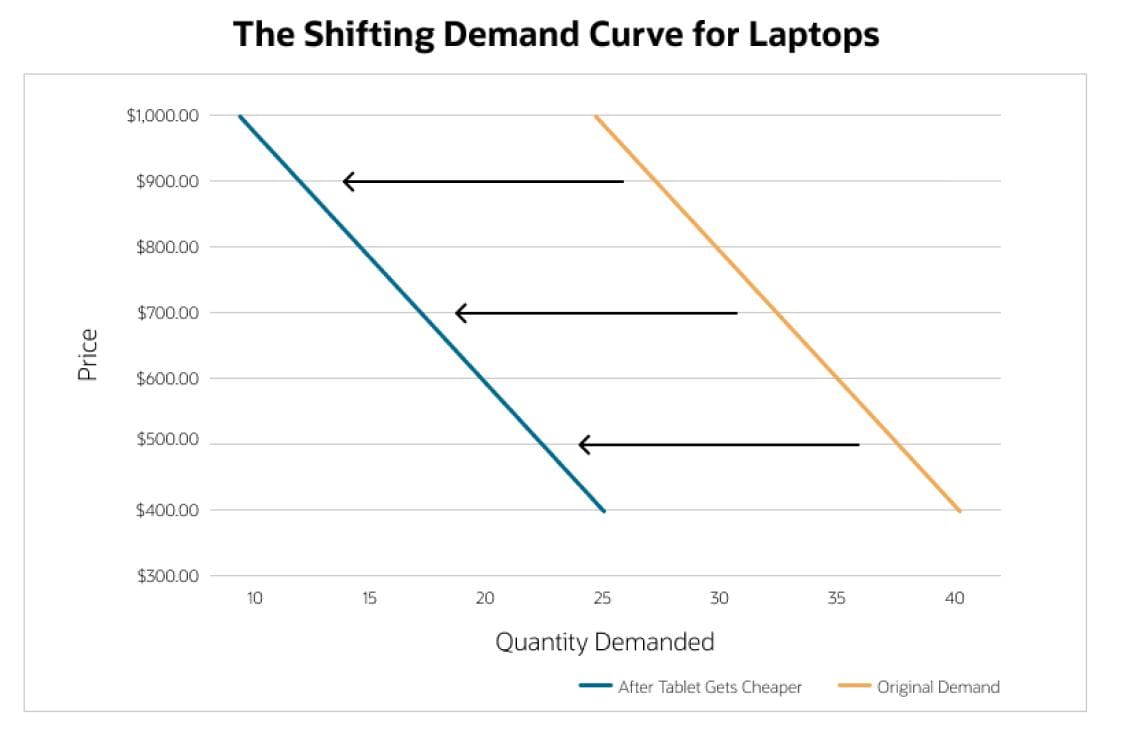When a business sells a product or service, it hopes that customers will want — nay, demand its offering. But demand is more complex than customers rushing to a store to grab the latest fad item before it sells out. Indeed, a variety factors influence demand.
A demand curve is the standard tool businesses use to understand changes in demand. It's represented by a simple graph that demonstrates the relationship between the price of a good or service and the quantity demanded at a specific period of time. A basic demand curve shows how demand fluctuates when only the item's price changes; all other factors, such as income level, remain unchanged.
But as we all know, the market is a complex place. Those other factors rarely stay the same
for long, and they impact the demand curve as well. Understanding the forces at play is
crucial for a company to properly forecast demand and prepare its inventory and pricing
structure
What Is the Demand Curve?
The demand curve is a visual representation of the law of demand in action. The law of demand, which applies to many typical goods and services, states that as the price of an item rises, consumers buy less of it. This is due to the increased cost relative to buyers' incomes, typically leading them to spend less on nonessential goods and luxury expenses, such as dining out or traveling, in favor of their basic needs, like rent and groceries.
Assuming all other factors remain equal, an item moves along the demand curve, which is usually slanted downward, or negatively sloped. Quantity demanded is plotted on the horizontal x-axis of the graph and price is listed on the vertical y-axis. The relationship between the two is inverse.
For demand to occur, a product or service must meet two criteria: Customers want it and are able to afford it. For example, if the price of a car increases from $40,000 to $45,000, the law of demand holds that fewer people will buy the car. All other factors affecting demand, like a customer's income level, remain constant. As a result, some customers will be priced out, others may decide it's financially prudent to repair their old cars, and still others may switch to public transportation.
However, per the law of demand, if the price of the car drops, demand for the vehicle will increase among those in the market for a new car.

Key Takeaways
- According to the law of demand, as the price of a product or service rises, consumer demand falls. A demand curve demonstrates this relationship graphically.
- When factors other than price influence demand, the demand curve shifts to the left or right.
- Demand for certain goods defy the law of demand when their prices change, and their curves take different shapes.
- How easily a product can be substituted for another — its elasticity — also influences demand.
- Understanding demand curves can inform inventory management and pricing strategies.
Demand Curve Explained
A demand curve reflects the relationship between price and demand of a product or service, though it doesn't explicitly explain why demand changes when prices rise or fall. That said, much of the reason can be attributed to opportunity cost, which is an economics term that refers to the value of what a consumer gives up, such as a dollar amount or perceived status, when choosing one item over another. Any given purchase takes up a certain percentage of a person's available money — money that can no longer be used to buy anything else. So the person must ask themselves: Is this item worth the cost, and is this the best use of my money?
How much of a particular item a household is willing to purchase at a given price is known as individual demand, which results in an individual demand curve. For example, if a household buys 10 pounds of chicken when it costs $1.82 per pound but only seven pounds when it costs $2.60, that data can be used to plot the individual demand curve.
When individual demand data is combined over a period of time in a particular market, a market demand curve results. For a business with a small customer base, an individual demand curve may be enough to inform product supply and pricing decisions. But as a business's customer base grows, it must consider the overall market demand to properly plan inventory, forecast demand and set prices.
How the Demand Curve Works
Many customers consider their options before making a purchase. If the price of a good is rising and that item can be easily substituted by another, the likelihood of the latter will increase. For example, a sudden hike in the price of a premium coffee brand might lead a customer to buy the lower-priced store brand instead. Economists call this the substitution effect. The corresponding demand curve for the premium coffee will show a decrease in demand as its price increases.
Every purchase consumes a percentage of a person's income. A change in income in either direction impacts their purchasing power, which in turn has repercussions on their demand. If our premium coffee fan loses her job, her individual demand for that coffee will likely decrease because it consumes more of her money, and she may turn to a store-brand coffee instead. On the flip side, if she were to receive a promotion and raise — signifying an increase in purchasing power — that person will continue buying the gourmet coffee, and perhaps a higher quantity. Either scenario is known as the income effect.
In summary, when our coffee customer can no longer justify or afford to buy the premium coffee, her demand for it decreases. The income effect and substitution effect help explain why this occurs. A business that is contemplating increasing its prices will want to think through the impact on demand and, ultimately, revenue.
Demand Curve Shape
Demand curves take the shape of a straight (linear) line or curve (nonlinear). A linear demand curve typically slopes downward as it moves to the right, demonstrating the inverse relationship between the quantity of products demanded (x-axis) and its price (on the y-axis) at a particular point in time.
A nonlinear demand curve also slopes downward but begins with a steep decline and flattens out as it moves to the right. A demand curve generally takes this shape based on consumer behavior at two extremes: when prices are very low or very high. For most goods, demand will be high if prices drop low enough, and the other way around. If the price of a gallon of gourmet ice cream suddenly doubles, for example, most consumers will switch to a less expensive alternative. Only the wealthiest of ice cream lovers would keep demand from ever reaching zero.
However, certain goods defy the law of demand when their prices rise and change the demand curve's slope. Businesses that are able to recognize when its products may or may not follow the law of demand will have an advantage in forecasting demand, allocating inventory and setting prices.
-
Giffen goods:
Giffen goods, named after Scottish economist Robert Giffen, are basic goods that typically account for a sizable portion of a lower-income consumer's budget and don't have many sufficient substitutes. According to the landmark 2007 study of Giffen behavior among poor households in two China provinces, when residents received a subsidy that lowered the price of rice, a main dietary component, their demand for rice actually decreased. Why? With less of their income needed to buy rice, they were able to afford more expensive food, namely meat. But when the price of rice increased, the residents could no longer afford as much meat, so they bought more rice, which increased demand. Giffen goods do have a limit, though, as demand will begin to fall when prices rise above what consumers can afford; in those cases, the curve will convey the traditional law of demand.
-
Veblen goods:
Veblen goods, named after American economist Thorstein Veblen, are goods like designer clothing, rare artwork and vintage wine, which are targeted at higher-income consumers and based on the idea that higher prices bring more social status or value. Speculative bubbles and viral products also behave in similar ways, as the perceived value of a stock or asset drives demand. As value increases, so does the fear of missing out, raising demand and motivating consumers to buy sooner rather than later.
Demand Curve Shifts
Factors other than price can influence demand for a product or service. For example, demand can skyrocket overnight when a product goes viral — such as a children's toy right before the holidays — with customers willing to pay a higher price than before it was a hot item. When this happens, the demand curve shifts to the right, raising the quantity demanded for each price on the curve. Higher incomes, reduced availability of substitute goods, increases in population and consumer expectations of higher prices can all shift demand to the right.
Conversely, when demand decreases due to a factor other than price, the curve shifts left. This can occur as a population's tastes change over time. For example, between 1995 and 2015, per capita American beef consumption fell from 66.4 pounds to 53.8 pounds, while chicken consumption rose from 68.9 pounds to 89.3 pounds. Beef experienced a left shift in demand, while chicken shifted right. Other factors that can cause a demand curve to shift left include lower household incomes, a change in government regulations, population reductions and expectations of lower prices in the future.

Types of Demand Curves
The appearance of a demand curve — from flat to steep — provides more information about a good or service than just the price and quantity demanded. It also conveys the item's resistance to price changes, known as its elasticity. Elasticity offers a business valuable insight into how much a price change will affect customer demand.
-
Elastic goods:
The more elastic a good is, the more demand will change when its price changes — resulting in a flatter demand curve. Entertainment and luxury items are considered highly elastic, as a large price increase for tickets to a live theater performance may motivate customers to go to the movies or stream a movie at home instead, for instance. Items that can be easily substituted also tend to be highly elastic. If a customer typically buys pizza for lunch but the price of a slice increases 50%, that person may choose to bring lunch from home instead. Generally, elasticity increases when the good is nonessential and easily replaceable.
-
Inelastic goods:
Goods consistently in demand and resistant to price changes are considered inelastic. Gasoline is an inelastic good because regardless of the price, consumers need to fill up their cars to get places, like work. While it's true some may switch to an alternative means of travel, such as a bus or train, most will pay the higher price, resulting in a steeper demand curve.

Demand Curve Examples
Demand curves can be created for every good or service purchased. Its steepness indicates the item's elasticity, and when the curve shifts to the left or right, it shows a new relationship between demand and price. A business seeking to maximize profits and reduce inventory inefficiencies must understand these differences to make sure it orders the right amount of supply to match customer demand.
For example, let's look at the demand for laptops at a hypothetical electronics store. Typically, the store sells 40 laptops per month when they are priced at $400 and 25 laptops when they cost $1,000. But a technological advancement in tablets, laptops' primary competition, suddenly causes more customers to purchase tablets over laptops. As a result, the store only sells 25 laptops at $400 and 10 at $1,000, shifting the laptops' demand curve to the left. Understanding how price changes and shifting market forces affect demand can help a business accurately forecast sales and maintain appropriate inventory levels.

Better Demand Forecasting With NetSuite
Demand forecasting helps businesses better prepare for their future inventory needs. It's also a complicated exercise best left to software. NetSuite Demand Planning helps businesses accurately forecast demand for their products and services, optimize stock levels and improve supply chain management by analyzing historical data, sales projections and seasonal trends. Using inventory management and demand-planning techniques, combined with a robust scheduling engine and predictive analytics, the solution provides businesses with real-time data upon which inventory-related decisions can be made with confidence. This means the right number of products and services will be available to meet customer demand, while excess inventory is kept to a minimum — all of which improves profitability and ROI.
A demand curve visual represents the relationship between a product's or service's price and consumer demand. But price isn't the only reason why demand changes, reflected in a curve's movement, steepness and, sometimes, direction. By understanding these factors and their impact on demand, businesses can more precisely forecast demand, optimize inventory management and better determine their prices.
#1 Cloud
Planning Software
Demand Curve FAQs
How do you explain the demand curve?
The demand curve is a visual model that explains the law of demand, which states that as the price of a good or service rises, consumer demand falls (and vice versa). This is because higher prices account for a greater proportion of consumers' income, which can motivate people to switch to a substitute or inferior good.
What is the demand curve called?
There are two main types of demand curves. An individual demand curve reflects the quantity demanded of an offering by one household. A market demand curve combines individual demand curves to reflect demand by an entire market.
What shifts the demand curve?
Forces outside of a price change can shift the demand curve to the left or right. Factors include changes in population, taste, consumer expectations, government regulations and income.
Why is it called demand curve?
It is called a demand curve because it reflects the quantity demanded relative to the price of a product.









